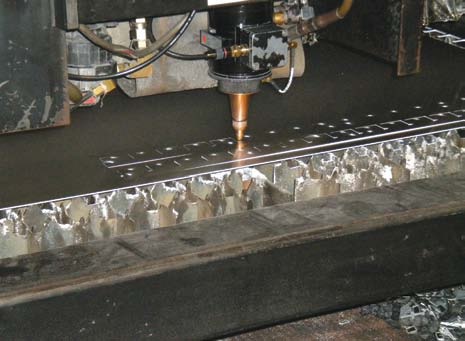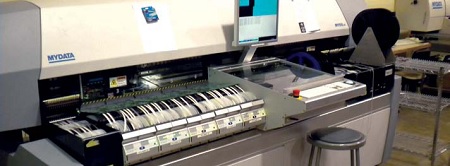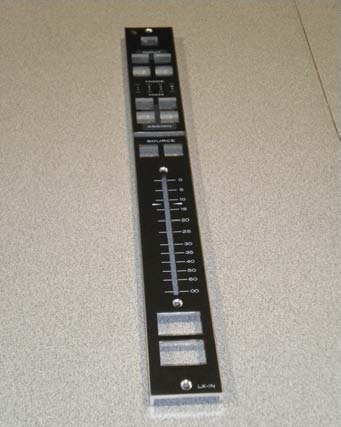Touring Wheatstone’s Factory

Phil Owens
NEW BERN, N.C.—One of the more interesting aspects of editing Radio World Engineering Extra is the occasional field trip to see some of our industry leaders. In November, I got the chance to visit Wheatstone Corp. in the small town of New Bern, N.C. It is a classic, U.S.-based manufacturing company: In one end come raw materials such as steel, wood, plastic and electronic components. Out the other side, finished products emerge as audio systems, consoles, routing switchers and audio processing. While the broadcast industry has had its share of large corporations to support its growth, it is also notable for the number of relatively small and agile companies that have been important players over the years. Many of these companies were founded by individual engineers or inventors who saw a need in the broadcast business and moved to fulfill it.

Laser used to cut custom steel parts for consoles and equipment chassis. Dimensions are finer and can achieve precision cutouts impossible for a traditional steel punch press. Unlike mass-market industries, broadcasting is more of a boutique business. Before consolidation, radio stations were all built one by one; service and customization were essential requirements. Even today it remains a business where purchases are most often made in small quantities.
Wheatstone is a good example of just this style of manufacturing. Completed items can often be traced back to the individual assembler that put in the last screw or finishing touch. Each system is assembled and tested individually before it is shipped to the customer. The exact configuration of any system is flexible and can be specified exactly as needed, whether a single studio with just a few faders or a set of large control systems at the heart of an enormous multi-station consolidation. Interconnections can be analog, AES digital, Ethernet or IP and in the exact number and type of each as ordered by the customer. There is a range of customization available for even the smallest systems.
Although it sounds strange, customers are looking for a custom experience when it comes to software too these days. By this I don’t mean that customers want the ability to write their own code necessarily, but they are concerned about the range of configuration choices and options that used to be hardware-based and now are done via software. The GUI is the new greenie tweaker.

Pick and place machine used to assemble surface mount component circuit cards. This machine is capable of placing eight components per sweep with an accuracy of 0.0001 inches. A good example of how this works in broadcasting occurs in audio processing. Wheatstone’s latest designs feature literally hundreds of controls that are settable in software. To help simplify setup, Wheatstone offers a customization service that will develop audio settings to your specifications. This is a subjective task and one that can really only be done by people using their ears to listen to the final product.
In their audio processor lab, Wheatstone has available both new and “classic” processors with analog and digital exciters coupled to modulation monitors. A customer can request a particular sound, perhaps to match an existing model of processor with a particular kind of music. Wheatstone can then work the configuration settings to match those requests in the lab before the new processor ships.
Get the TV Tech Newsletter
The professional video industry's #1 source for news, trends and product and tech information. Sign up below.

This module strip from the new LX series uses a new powder coat paint process with the labels etched using a small laser. The result is dramatic contrast and more durability than obtained with traditional silkscreen techniques. So what did I see during my visit to the New Bern headquarters? There was the latest in modern equipment for making surface mount hardware, which transforms a computer file and spools of components into an assembled card. A specialized camera system is used to take high-resolution photographs of the finished boards that can detect within thousandths of an inch if a component is misplaced or improperly soldered.
For mechanical parts there’s a laser steel cutter that cuts patterns too intricate for a traditional punch machine. New to the floor was a multi-axis CNC milling machine busily drilling patterns into aluminum panels. In another corner, a computer controlled milling machine cut out wooden chassis ends.
Wheatstone takes pride in deploying the latest and best technology available to manufacture their equipment. This was apparent in how eager the line workers were to show off what their equipment could do for an outside visitor like myself. Their investment in technology has paid off in high quality and higher productivity; according to President Gary Snow, the output from this factory has more than doubled over the last five years while the number of people required to run it remains about the same.

CNC milling machine. Using a computer program and exchangeable heads, this device, shown working on a set of module plates, can mill holes and panel openings with precision to about 0.001 inches. It seems that when we speak about modern manufacturing the torch has been passed to other countries and overseas. That’s why it’s so refreshing to see a company like Wheatstone so committed to making their products in the United States.
My thanks to the kind staff at Wheatstone for their hospitality in showing me around the factory floor and tolerating my endless questions and interruptions. In particular thanks to Gary Snow for making the tour possible, and Vice President of Engineering Andrew Calvanese for an interesting conversation about the future of audio technology. And finally, my thanks to patient and helpful Eastern U.S. Sales Engineer Phil Owens for shepherding me around so that I would not miss anything. I enjoyed this tour immensely and was impressed at every turn.
Michael LeClair is chief engineer for radio stations WBUR(AM/FM) in Boston.
